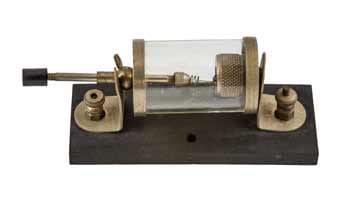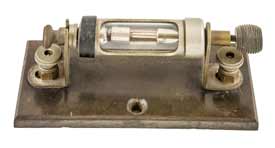Crystal Detector: Cat's Whisker Radio Detector
The Cat's Whisker was used in vintage crystal radio sets and its performance was crucial to the operation of the whole radio.
Crystal Radio Sets History Includes:
Crystal radio sets
Crystal radio circuits
Crystal detector
Crystal radio components
Iconic radio receivers:
Summary of iconic radio receivers
Radio receiver history
Radio history / timeline
The cat's whisker detector is one of the most iconic components used in vintage radio sets. Also called the crystal detector it was an iconic component used in many antique radio equipments.
Today, many cat's whisker or crystal detectors sets can be seen in the antique and vintage radio collectors market.
In their day, the radios using the cats' whisker detector or the crystal detector performed well and for many years they were the main type of detector used in sets used for the reception of broadcast transmissions.

The development of the crystal detector or cat's whisker itself resulted from the observations made by people researching into antique radio technology, although they had little understanding of the principles because they are a form of semiconductor diode, and the basic theory behind this technology was yet to be discovered.
Operation of crystal or cat's whisker detector
There were various formats for crystal detectors. However they relied upon the fact that a PN junction as made, and this reacted as a diode rectifier. It had been noticed that current would only flow one way through the diode, and this gave it is detecting action.

There were a number of methods that were used to create crystal detectors. The most common was to use a crystal mounted in a crystal holder. A thin copper wire known as a cat's whisker (hence the name of the overall detector) was then connected to a holder that could be moved to allow the wire to be placed on a suitable position on the crystal.

At the point where the wire contacted the crystal a point contact diode was formed. Although it would not conduct high currents, it was ideal for receiving radio signals.
An alternative form of detector called a "Perikon" detector used two crystals in contact with each other.
It is possible to plot the IV response curve of a typical cat's whisker detector that was used in a vintage radio. Looking at the curve below it can be seen that it has turn on voltage is around 0.2 volts, but even below this voltage it still has some diode action which could be used for signal rectification and hence detection.

To obtain the best response the cat's whisker wire needs to be on what was termed a "hot" spot on the crystal. The diode assemblies allowed for the selection of different points on the crystal. Often these would reduce in performance after a while and a new spot needed. When all the useful points on the crystal were exhausted, a new crystal could be bought and inserted into the cat's whisker assembly.
Modern day diodes can also be used. They should be germanium diodes as these have a might lower turn on voltage than silicon ones. It can be seen they have a very similar response to that of the galena cat's whisker diodes.

Normal silicon diodes will not perform well as they have a very much higher turn on voltage which is also much sharer, so very little rectifying action takes place below their turn on voltage of around 0.6 volts.
Using a cat's whisker detector
In general the cat's whisker crystal detectors were reasonably reliable by the standards of the day. Those used in the early 1900s proved less reliable than the later ones. This was mainly as a result of the way they were used. They were used alongside powerful spark transmitters. It was found that the transmitter caused high voltages and current levels to be generated in the diode detector and it required repositioning once the spark transmitter had ceased operating and the receiver was required.

This effect was found to be less pronounced with carborundum detectors that used a steel spring with a higher tension on it that exerted a greater force on the crystal.
In normal domestic use, the cat's whisker crystal detector operated reliably and the wire only needed repositioning relatively infrequently.
Usage of the cat's whisker detector
The cat's whisker detector came into its own with the rise of broadcasting. The detector was relatively cheap and provided a reliable means of detecting signals. In addition to this it required not batteries like the thermionic valves (vacuum tubes). In addition it offered much better tonal quality than the valves of the early 1920s which were also very expensive.
Different crystal types
A wide variety of different types of material were used in the heyday of the crystal radio set. Each type had slightly different properties and they each had their own following of people who supported them as the optimum type.
The different properties of the different types of crystal used in the cat's whisker detectors enabled them to be used in different ways.
Most of the substances used in the crystal detectors were either sulphide or oxides they would have been semiconductors, although they would not have been widely classified as such.


There was an interesting variety of different types of crystals used in cat's whisker crystal detectors for these vintage radios:
- Galena: Galena was the most widely used mineral in crystal detectors at the time. It was said to have "well defined" rectifying properties and it "affords reception of very great tonal quality." Crystal detectors made from galena were cheap as a result of the plentiful supply of the raw mineral.
Galena is a form of lead sulphide and has the formula PbS. The material for the cat's whisker detectors was mined in various parts of the world, but supplies in the 1920s for radios generally came from Southern France, in the Andalusian area of Spain, and in Mexico. A couple of mines in England also supplied the burgeoning radio or wireless industry.
For general use, it was found that a galena crystal with a moderately fine cat's whisker contact produced good results. - Zincite: This was another popular form of crystal for radio detectors.
- Synthetic zincite: As a result of the scarcity of the naturally occurring zincite, it was also produced artificially. It was produced by fusing ordinary white zinc oxide at high temperature and then allowing it to cool slowly. It then formed hard yellow lumps of the mineral. In this form it was marketed as "Synthetic yellow oxide," "Gilvium," "Azinite," and a number of other trade names.
- Bornite or copper pyrites: These material are sulphides of copper. Bornite has an iridescent appearance. These crystals worked well as combination crystals in conjunction with zincite. It was also found that copper pyrites worked well with a tellurium contacts.
- Iron pyrites: Iron pyrites is a very common mineral basically it is iron sulphide and often referred to as "fools gold" on account of its looks. However the exact forms of iron pyrites that can be used in radio crystal detectors are not common otherwise it would have proved to be a very serious rival to galena in view of its properties and performance. It was found that it was able to provide an almost uniform performance over the whole of its surface and it could withstand the effects of heat reasonably well. It was also found that it would retain its sensitivity for a much longer period than galena. In addition to this it provided reception with a good tonal purity.

- Silicon : Although silicon is extremely widely used in modern semiconductor technology, during the 1920s it was rarely used. Initially it experienced some popularity, but this waned. Synthetically made silicon was used, and it was found it performed best with a fine wire of brass or phosphor bronze to make the point contact.
- Tellurium: Tellurium, Te is an element having an atomic number of 52. It is a brittle, mildly toxic, rare, silver-white metalloid (i.e. half way between a metal and non-metal) which looks similar to tin. It is only occasionally found in native form, as elemental crystals.
As a crystal radio detector it gave excellent results when used with zincite, especially zincite in its synthetically produced form, although it worked well with other crystals including silicon and galena as well as copper and iron pyrites. - Molybdenite : This is a naturally occurring form of the sulphide of molybdenum. It was never widely used because it required the construction of a special assembly for its use, although what were termed good specimens of the material would perform satisfactorily with an ordinary cat's whisker contact.
- Carborundum : Carborundum, or to give it its chemical name, silicon carbide, SiC, is a particularly hard substance that even today is used as a semiconductor. Even in the 1920s it was known to be able to withstand very high temperature's without any loss in performance, although why this would be of use was not stated.
Silicon carbide occurs naturally as the very rare mineral named moissanite. However, silicon carbide powder has been mass-produced since 1893 for use as an abrasive.


Constructors of these early vintage crystal radios in the 1920s used these crystals and experimented with the different types to gain the optimum performance. Stockists of the various parts required for making wire-less sets would normally be able to provide a variety of different crystals and the assemblies in which they were mounted.
Today vintage radios using crystal detectors can still obtain crystals from various specialist stockists.
 Written by Ian Poole .
Written by Ian Poole .
Experienced electronics engineer and author.
More History:
Radio history timeline
History of the radio
Ham radio history
Coherer
Crystal radio
Magnetic detector
Spark transmitter
Morse telegraph
Valve / tube history
PN junction diode invention
Transistor
Integrated circuit
Quartz crystals
Classic radios
Mobile telecoms history
Vintage mobile phones
Return to History menu . . .


